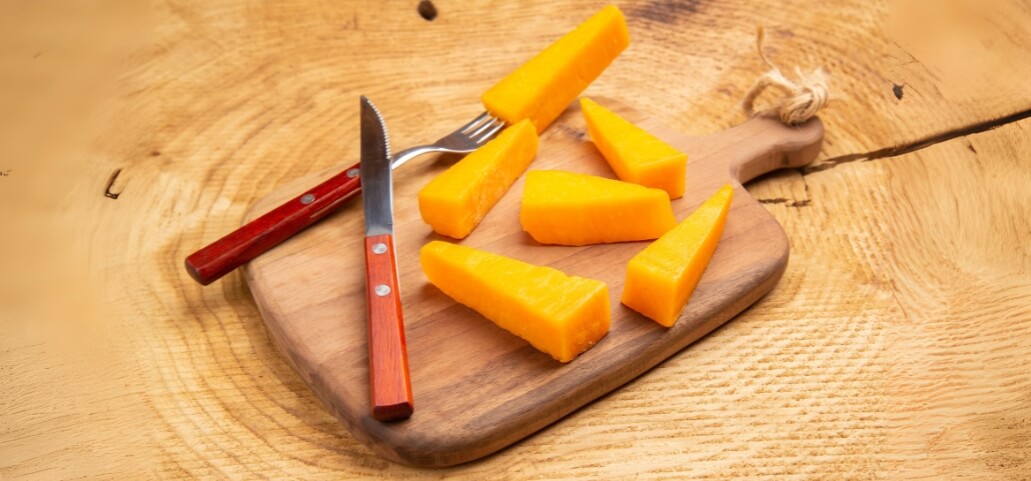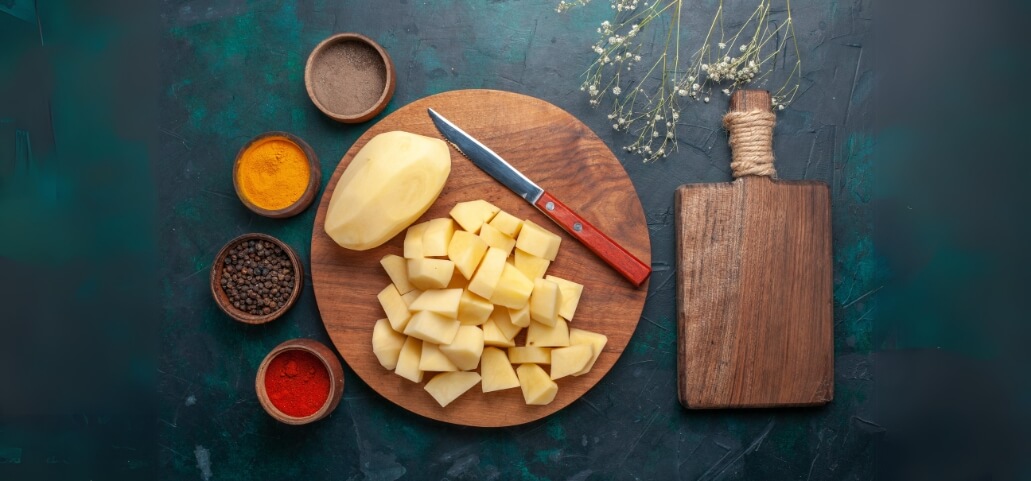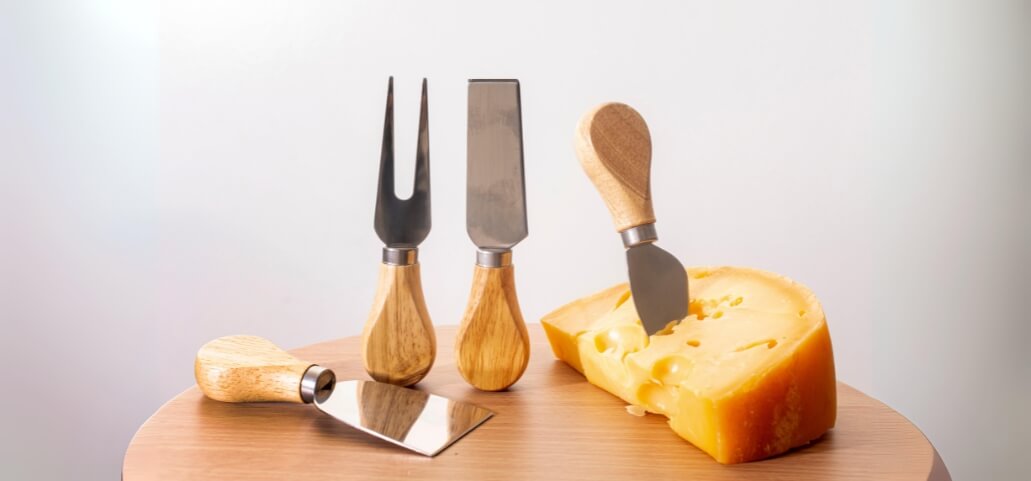Knowing how to use cheese knives is essential for enthusiasts and home entertainers, it enhances both the appearance and taste of cheese platters. This guide covers different types of cheese knives, tips for selecting the right one, cutting techniques, and maintenance advice, helping you perfect the art of cheese cutting and impress your guests. So let’s dive in and explore how to use cheese knives.
Types of Cheese Knives and Know How to Use Cheese Knives
In the realm of dining etiquette, each cheese knife is designed for a specific cheese and should not cross-serve among different types. Herein, we delve into a compendium of common cheese knives, delineated from those crafted for soft cheeses to those intended for hard varieties. Let’s explore their usage and the cheeses they are best paired with.
Knives 1: Soft Cheese Knife
The soft cheese knife, often referred to as an open-work blade knife, is uniquely designed with numerous perforations that serve a dual purpose. These perforations reduce the adhesion of soft cheeses by minimizing the contact surface between the cheese and the blade, making slicing smoother and more efficient. Additionally, these apertures aid in dislodging cheese from the blade, preventing it from sticking and ensuring clean cuts.
- Attributes: Keen edge, perforated blade, ergonomic handle for comfortable slicing
- Cheese Texture: Soft to Semi-Soft, including creamy and spreadable varieties
- Ideal Cheeses: Brie, Camembert, Fresh Mozzarella, Goat Cheese, and other delicate, soft cheeses
Knives 2: Cheese Spreader
A cheese spreader, also known as a spatula knife, is a specialized utensil designed for the application of spreadable cheese varieties onto bread and crackers. This handy tool typically features a blunt edge and a rounded blade, making it perfect for smoothly spreading soft cheeses without damaging the bread or cracker surface.
- Attributes: Blunt edge, rounded blade
- Cheese Texture: Soft
- Ideal Cheeses: Robiola, Stracchino, Cream Cheese
Knives 3: Gorgonzola Knife
Resembling a cheese spreader, the Gorgonzola knife is specifically tailored for creamy cheeses but also features a sharp edge designed to cut through rinds with ease. This unique knife is perfect for those who enjoy a variety of textures in their cheese selection.
- Attributes: Rounded blade with one sharp edge for dual-purpose functionality
- Cheese Texture: Ideal for Soft, Semi-Soft, and Crumbly cheeses, providing versatility in cheese preparation
- Ideal Cheeses: Perfect for Gorgonzola, Blue Cheese, and other similarly textured cheeses
Knives 4: Pronged Cheese Knife
The pronged cheese knife, also known as the forked-tipped spear, is a versatile and multifunctional implement designed for cheese lovers. This tool allows one to seamlessly slice and then spear cheese for serving, making it an essential addition to any cheese platter. Its narrow blade ensures that soft cheeses don’t adhere to it, allowing for clean and precise cuts.
- Attributes: Upward-curved narrow blade, sharp edge for easy cutting, pronged tip for spearing and serving
- Cheese Texture: Suitable for a range from soft to semi-hard cheeses
- Ideal Cheeses: Perfect for a variety of cheeses such as Parmesan, Brie, Camembert, and softer blue cheeses
Knives 5: Slim Blade Cheese Knife
Characterized by its minimal surface area, the slim blade knife prevents soft cheeses from clinging to it, ensuring clean and smooth cuts. The handle is offset, designed not only to provide a comfortable grip but also to protect the user’s knuckles from coming into contact with the cutting surface. This thoughtful design enhances both safety and precision.
- Attributes: Thin narrow blade, sharp edge, elevated handle for knuckle protection
- Cheese Texture: Ideal for soft to semi-hard cheeses, allowing for easy slicing without sticking
- Ideal Cheeses: Perfect for delicate cheeses like Camembert and Boursault, this knife ensures you can enjoy every slice without any hassle
Knives 6: Flat Cheese Knife
A flat cheese knife, also known as a chisel knife, is specifically designed to shear slices off aged cheeses through a precise downward motion. This method ensures that the slices are cleanly cut, preserving the texture and appearance of the cheese. The sharp edge of the knife further refines the pieces, allowing for a perfect presentation.
- Attributes: The knife features a broad, flat blade with a sharp bottom edge, which enhances its cutting efficiency.
- Cheese Texture: It is best suited for cheeses with a semi-soft to semi-hard texture.
- Ideal Cheeses: This versatile tool is perfect for slicing cheeses like Provolone, Swiss, Gruyère, and Asiago, making it a valuable addition to any cheese lover’s collection.
Knives 7: Narrow Plane Knife
Also known as a trapezium knife, the narrow-plane cheese knife is adept at slicing and chipping away at cheese blocks, featuring dual sharp edges for precision cutting. Its specialized design allows for both short and long edges to be sharp, making it versatile for a variety of cutting techniques.
- Attributes: Narrow blade, both short and long edges are sharp, ergonomic handle for better grip and control
- Cheese Texture: Suitable for Semi-Soft to Hard cheeses, ensuring clean cuts without crumbling
- Ideal Cheeses: Perfect for a range of cheeses such as Gouda, Cheddar, Jarlsberg, and even Manchego
Knives 8: Cheddar Cheese Knife
Known as a mini cleaver or cheddar cleaver, this knife is specifically engineered for cutting hard cheeses with precision and ease. Its wide rectangular blade and cleaver shape efficiently leverage force and balance to cut clean and even slices. The handle is ergonomically designed and positioned to avoid any knuckle contact with the cutting board, ensuring a comfortable and safe cutting experience.
- Attributes: Wide rectangular blade, sharp long edge, ergonomic handle with a comfortable grip
- Cheese Texture: Suitable for cutting Semi-Hard to Hard cheeses
- Ideal Cheeses: Perfect for slicing Cheddar, Gruyere, Colby, Fontina, and other similar hard cheeses
Knives 9: Parmesan Knife
This knife, featuring a pointed edge, is ideal for breaking chunks off hard and dry cheeses such as Parmesan. The knife is available in both bell and compact styles, each designed for effective cheese rind penetration. The bell style offers a traditional look with a comfortable grip, while the compact style is perfect for easy storage and handling.
- Attributes: Sharp-pointed tip, triangular stubby blade, sharp long edge, ergonomic handle for comfortable use
- Cheese Texture: Hard, dry, and aged
- Ideal Cheeses: Parmesan, Castelmagno, Grana Padano, Pecorino Romano
Knives 10: Hard Cheese Knife
Typically the largest of cheese knives, hard cheese knives are specifically designed for applying downward pressure to cut through aged cheese wheels or wedges. These knives are often equipped with dual handles, allowing for balanced pressure and controlled slicing. The long straight blade and sharp edge ensure clean cuts through even the hardest cheeses.
- Attributes: Long straight blade, sharp edge, one or two handles for added stability and control
- Cheese Texture: Hard, aged varieties that require more force to slice
- Ideal Cheeses: Asiago, Extra Mature Cheddar, Provolone, Comte, Parmesan, and other dense, firm cheeses
Additional Cheese Tools

Cheese knife kits may include auxiliary tools to aid in cutting and serving. Here are some commonly encountered tools:
Knives 1: Cheese Wire
A cheese wire, also known as a bow knife, is specifically designed for cutting delicate soft cheeses cleanly without crushing them. It typically appears either as a bow-shaped tool or is affixed to a cheese board for stability and precision.
- Attributes: The tool usually features a thin metal wire and may come with a bow or a handle for ease of use. The wire is taut and sharp enough to slice through soft cheese effortlessly.
- Cheese Texture: Ideal for cutting soft to semi-soft cheeses, ensuring the texture remains intact.
- Ideal Cheeses: Perfect for cheeses like Fresh Mozzarella, Ricotta, and Robiola, where maintaining shape and presentation is important.
Knives 2: Cheese Plane
The cheese plane is meticulously designed to achieve perfect, thin slices of cheese. As you glide it along the surface of the cheese, the thin slice effortlessly rests on its spatula-like top, ready for serving or presentation. The tool is not only functional but also elegant, making it a must-have in any cheese lover’s kitchen.
- Attributes: Equipped with a spatula-like paddle featuring a sharp-edged slit, the cheese plane ensures precision and ease of slicing.
- Cheese Texture: Best suited for cheeses that range from semi-soft to semi-hard, ensuring optimal performance.
- Ideal Cheeses: Perfect for slicing a variety of cheeses such as Fontina, Havarti, and Muenster, allowing you to enjoy these delicious cheeses in the perfect thickness.
Knives 3: Cheese Rind Cutter
This tool, featuring a precisely pointed tip, is expertly crafted to score hard cheese rinds, making them easier to open and ensuring a seamless experience when preparing your favorite cheeses.
- Attributes: Pointed downward tip for precision, sharp edge for efficiency
- Cheese Texture: Suitable for Semi-Hard to Hard cheeses
- Ideal Cheeses: Perfect for Parmigiano Reggiano, Grana Padano, and other similar hard cheeses
Knives 4: Cheese Grater
A cheese grater is an indispensable kitchen tool for shredding cheese. It typically features multiple sides with different-sized razors to accommodate various shred sizes. The razors are strategically designed on a flat plane to ensure efficient and uniform shredding.
- Attributes: Equipped with several sharp razors on a flat plane, often stainless steel, providing durability and ease of cleaning.
- Cheese Texture: Best suited for semi-hard to hard cheeses, ensuring smooth and even shreds.
- Ideal Cheeses: Perfect for grating Parmesan, Romano, and other similar hard cheeses, adding a delightful texture to your dishes.
Knives 5: Cheese Fork
Useful for picking up cut pieces from a cheese board, a cheese fork can also break larger blocks into smaller chunks, making it an essential tool for cheese lovers and party hosts alike. Its design is particularly convenient for handling a variety of cheese types without making a mess.
- Attributes: Two pointed prongs, typically made of stainless steel or other durable materials, designed to easily pierce and lift cheese pieces.
- Cheese Texture: Semi-Soft to Hard, ensuring versatility for different cheese preferences.
- Ideal Cheeses: Feta, Cheddar, Provolone, Gouda, and Parmesan, among others, allowing you to impress your guests with a well-prepared and elegant cheese platter.
How to Select the Right Cheese Knife

When choosing a cheese knife, consider the type of cheese you most frequently consume and its texture. Different knives are crafted with specific attributes to create an optimal cheese-cutting experience.
- For soft cheeses: Cheese spreaders, Gorgonzola knives, and pronged cheese knives are ideal.
- For semi-soft cheeses: Slim blade cheese knives, flat cheese knives, narrow plane knives, and cheddar cleavers work best.
- For hard cheeses: Use cheddar cleavers or parmesan/mini-cleaver knives for breaking chunks off larger wheels or wedges.
- For several cheese types: Consider purchasing a cheese knife set with multiple varieties to cover all your cutting needs.
Additionally, cheese knives should be easy to grip and maneuver. Consider the handle size and material based on your personal preferences.
Maintaining Your Cheese Knives
To keep your cheese knives in top condition for future use, follow these tips:
- Clean your knives after each use with warm water and mild soap, avoiding harsh chemicals that might damage the blades.
- Whip out a soft towel or cloth and dry your blades right away.
- Store your knives in a designated cheese knife block or wrap them individually in protective covers to prevent dulling or damage.
- Sharpen your knives periodically using a sharpening stone or professional sharpening service.
- Handle your cheese knives with care, avoiding dropping or banging them against hard surfaces.
Conclusion
Mastering the art of using cheese knives can elevate your entertaining skills and enhance your cheese-tasting experience. By understanding the different types of cheese knives and their uses, selecting the appropriate knife, and employing proper cutting techniques, you can create impressive cheese platters that will delight your guests. To get the most out of your cheese knives, be sure to give them the TLC they need.
Frequently Asked Questions
Q1: How to use cheese knives effectively?
Answer: When using cheese knives, always start by placing the knife blade on the edge of the cheese and applying gentle pressure to create a small indent. Then, using that indent as a guide, slowly cut through the cheese in one fluid motion.
Q2. How do I prevent cheese from sticking to the knife?
Answer. Use a knife with a thin, narrow blade or one with holes or a serrated edge. These features reduce friction and prevent the cheese from sticking.
Q3. Can I use a regular kitchen knife to cut cheese?
Answer. While you can use a regular kitchen knife, specialized cheese knives are designed to handle different textures and types of cheese, providing better results.
Q4. How often should I sharpen my cheese knives?
Answer. The frequency with which you sharpen your cheese knives should be proportional to their usage. Regular honing can help maintain the edge between sharpenings.
Q5. What is the best way to store cheese knives?
Answer. The best way to preserve the edge and safety of your cheese knives is to store them in a knife block, magnetic strip, or protective sheath.
Disclaimer: Please note that the objective of this blog article is purely informative. Both anecdotal evidence and academic studies formed the basis of the presented data. When working with sharp things, use extreme caution. If you are unsure how to handle or care for your cheese knives, it is best to get advice from an expert.
Personal Experience: As a cheese enthusiast, I have experimented with various cheese knives and techniques over the years. I found that using the right knife for each type of cheese significantly enhances the presentation and tasting experience. My favorite knife is the soft cheese knife, as it allows me to create beautiful, clean slices of Brie and Camembert without any mess. If you’re new to tasting cheese, I hope this is a helpful guide.
Why Trust Our Content?
Professionals in the fields of cheese tasting and entertainment write and conduct extensive research for our content. If you want to make smart choices, you need access to reliable information, and we aim to do just that. Our goal is to enhance your cheese-tasting experience and ensure you have the best tools and techniques at your disposal.

